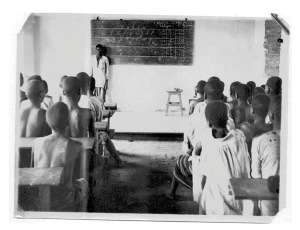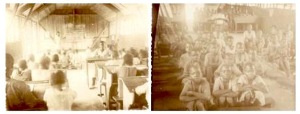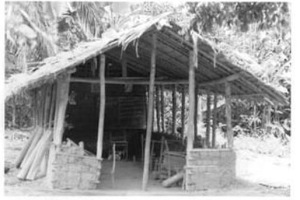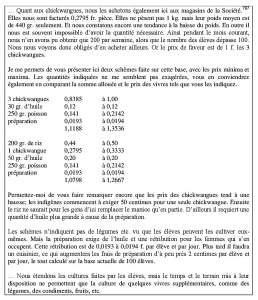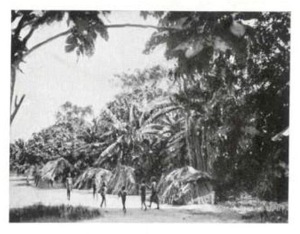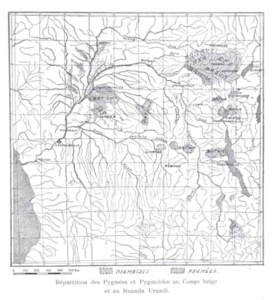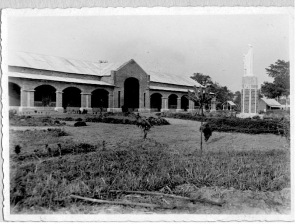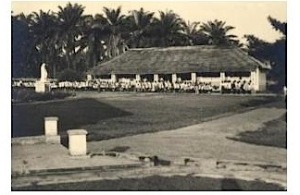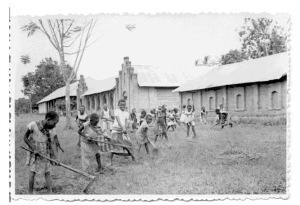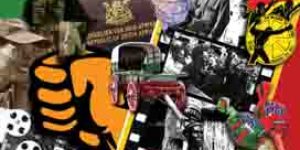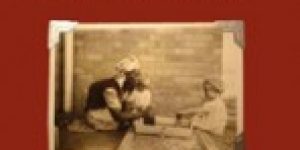When Congo Wants To Go To School – Educational Comfort
No Comments yetThis chapter is primarily concerned with the development of the ‘educational comfort’ in the region of the MSC. This term must be further explained. ‘Educational comfort’ was used by Marc Depaepe to describe a larger body of elements that, taken together, contribute to the ‘comfort’ of education and of being taught. In the first instance I will be concerned here with the material organisation of the educational activity. As was set out in chapter 3, the missionaries built up a network of schools. This building must also be taken in the literal sense of the word. The material aspect of education is often the best documented, in the form of archives and other sources. The schools at the larger mission posts are mainly those referred to in the different articles and reports. This implies that the general picture is unavoidably a little distorted, even here, because the mission posts were much better equipped than the little schools in the bush.[i] ‘Educational comfort’ is naturally not only the material equipment, it is also everything that goes with or is connected with the existence of a building in which education is undertaken. By this I do not mean that I am primarily concerned with everything that is used in teaching in the colonial classroom, although that does contribute to the full picture. ‘Comfort’ includes the integration of the schools in the society as much as in the mission posts and also the upkeep, the material aspect of living. Or, to put it another way, the ‘material management’ of education. Other aspects of the reality of classes, such as discipline and timetabling, will only be considered later.
Appearance of the classroom
Before moving to information that comes from the written sources, I wish to present on a few photographs of ‘classroom life’. Such pictures are rather scarce, certainly within the boundaries of the MSC mission region. They are naturally interesting because they visually present a particular aspect of reality. It is true that this relates more to the material environment than the behaviour, considering that the ‘life’ shown is posed in many cases. Everything naturally depends on what one allows the photographs to tell. The descriptions that follow here give a vague idea of what it was like then, although they raise as many questions as they answer.
The photographs in image 15 show a school in Nsona Mbata (in the neighbourhood of Matadi) in 1922. The pupils are in a building, in any case they are more or less closed off from the environment and they have some protection against the vicissitudes of the climate. It is difficult to say whether this is a room that is specifically meant for education. What is noticeable in the photograph is that there is certainly more than one teacher operating in the same room. The children are evidently divided into groups. At first sight there are four groups of children, on closer inspection five can be distinguished (on the right-hand photograph they can all be seen, three at the back, two at the front). The first teacher stands at the blackboard and teaches something about a text written on the board. It is not clear what the topic is. In an enlargement of the photograph it seems to be about syllables, which could indicate that this was a reading lesson. The second teacher is sitting at a table as are the pupils who are clearly forming his class. There is a pile of papers on his table (exercise books or textbooks?) and there is also a clock (an alarm) and there is something lying there that looks like coins. The second teacher also has a blackboard that (perhaps because of the photographer) is pushed completely to the side. In total there must be between fifty and seventy children sitting together in this room. The group at the back, who are sitting on school desks, clearly have slates and slate pens, which they are using. With the groups at the front these instruments cannot be seen and a few pupils seem to be holding something (an exercise book?).
The photograph in image 16 is a picture of a class in the MSC missionary region from around 1950. The material environment in which the lesson is given is very sober but shows more specific characteristics that are commonly associated with the concept of ‘school’ in comparison to the previous photographs. The teacher – who poses stiffly – stands on a platform before the class. On the large blackboard that is fixed to the wall there are a number of letters on the left, which indicate a writing lesson. A number of arithmetic sums can be seen on the right. The school desks are narrow and more than two pupils sit at them at a time. As far as can be seen, the room being used as a classroom is built in stone and the walls are more or less plastered. On the floor there is also some sort of stone or paving. The school is clearly built from some sort of durable material. Still, this is supposed to be a rural school, going by the clothing of the pupils and above all the assistant. He is wearing a pagne, which would not have been permitted at the mission posts.[ii] Finally, the photographs in figure 17 are taken at a central mission school. The classrooms have glass windows. On the photograph on the left a sort of overhang can be seen behind the frame, probably a barza, which makes one suppose that the classroom is part of a larger school building.[iii] The school desks have a better finish, the pupils sit in pairs. They are not wearing uniforms but it is clear that there is a sort of dress code. On the left there is a map of the Belgian Congo on the wall together with a few other undoubtedly didactical pictures. On the right, pictures are also on display and a cupboard with didactical material (probably measuring vessels). These classes undoubtedly look the most ‘European’.
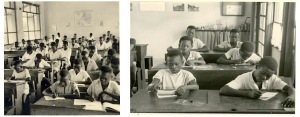
Image 18 – Classes in central mission schools, MSC mission area, in the 1950s. MSC Borgerhout Collection
The last ‘class photograph’ (image 18) is even more richly filled but the quality of this classroom is not necessarily better than the classrooms on the previous photographs. The building, which is visible in the next photograph, also looks to be built in durable materials, although that cannot be said for certain on the basis of these pictures. However, the roof is not tiled, it seems to be covered with thatch or planks, probably ndele.[iv] The wooden lathes of the roof trusses are visible on the inner side and there seems to be a space between the wall and the roof (light is shining through the opening). In contrast, the interior seems to be richly decorated. This impression is naturally partly aroused by the angle of the photograph. In any event there is a large school board, which has been filled for the occasion with writing, arithmetic exercises and in the middle a large drawing which shows the ‘sacred heart’. Above the board a whole series of pictures have been hung. These are more than likely religious in origin. The picture is reminiscent of a religion lesson, partly because of the presence of the nun on the photograph. The school desks look solid and the pupils well groomed, although the dress code does not seem to have been very strict. The pupil in the centre front only has a vest on, the pupil on the right of the photograph has a large hole in his shirt. The description of the photographs makes it clear that in spite of their visual character, they can only reproduce a part of the reality.
Building schools
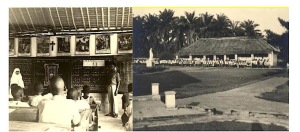
Inside the boys’ primary school in Bokote, with Sister Jozefa (Daughter of Our Lady of the Sacred Heart) and a teacher, 1956; The boys’ school from the outside. MSC Borgerhout Collection
With regard to the school building in the strict sense we should be able to distinguish three phases, although the chronology can not always easyly be distinguished. There was a start-up phase, which was really more unique to each location in itself than representing a clear period or a clear block within the colonial period. This start-up phase was very often characterised by starting up an activity without a suitable material infrastructure. This logically developed into a sort of consolidation, characterised by building or setting up a room or a classroom specifically intended for and adapted to the provision of education. It is my hypothesis that this was generally accompanied by the consolidation of a mission post, at least in the case where a central mission post was concerned. In the case of the bush schools somewhat more cautious argument is required because the situation there was not as clear. In a third phase, the situation had finally evolved to such an extent that it could be described as the professional management of the school activity and the school buildings. As has been said, the three phases are to be considered more as phases of the life cycle of a mission, the village, or of an individual school. The colonial period cannot be divided into three clearly defined phases. In the next paragraphs I will mainly try to illustrate clearly what these phases looked like at different locations. At the same time, I will attempt to visualise the appearance of the school at the mission post using drawings, illustrations and photographs.
2.1. Start-up phase
When the MSC came to the region in 1924 they were confronted with an existing but limited infrastructure. The Trappists had always given priority to evangelisation in the strict sense. Furthermore, they were never present in very great numbers, which also must have reduced their power considerably. One of them, Father Sebastianus, reported on their Tsuapa mission. He spoke of the “small number of missionaries, which has never been more than thirteen.” He spoke of the achievements up to that time: “situated as the first place up the river, is a town with approximately 250 or so Christians.“ Here it must be remarked that anyone who was not a Christian was systematically ignored in this sort of report. Consequently, it is very difficult to estimate how many people really lived there. The Father continued his report about the different villages in the area he had visited: “nearly all worked for the state or for merchants. A chapel, built in 1913 or 1914, had collapsed. The house in which the Father lodged was at the point of collapse. I believe there is now a chapel and house there.” Occasionally, he spoke of the construction of one building or another. He wrote about Mondombe: “In the month of July of the year 1924 I built a large chapel here thirty metres long by six metres wide.” And about Yalola: ”Yalola is really more beautifully situated. In this place I built a house in 1923, thirty metres long by nine metres wide, with the intention that a mission might come here.“ He added a list of places where there were catechists and added the comment: “At all of the above named places there is a chapel and a house for the Father.” He reported nothing at all about schools.[v]
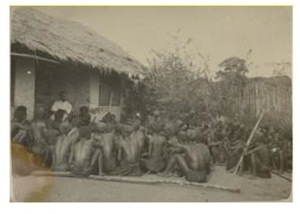
Teaching by a Father in the Equatorial province. Probably Father Yernaux in Mondombe. MSC Borgerhout Collection.
In a letter from 1920, from the Trappist superior Kaptein to the governor-general, it seems that in each of the five mission posts there was a boys’ school.[vi] In the whole area, in contrast, there was only one girls’ school.[vii] In the first report by the MSC about the Congo in the Annalen (March 1925) there was immediate mention of school buildings. Father Van der Kinderen wrote about Bokote: “First of all a house will have to be built for the Sisters, whom we expect with excitement; then our own house of clay replaced by one of brick, and in between these a new church has to come because the current chapel is ready to fall down. The new school for the boys is almost ready but for the moment it will have to house the newly arrived Brothers and Fathers.”[viii] In the years following the first arrival, more and more missionaries departed for the Congo. The reports, which they sent home, were often printed in the Annalen. Already in 1925 and 1926 they reported on new establishments, where there were always new school buildings to be prepared. At the end of 1925 Edouard Van Goethem reported a new foundation in Boende under the leadership of Father Van der Kinderen, who for the time being was staying “in the house of the State agent” and collected a group of children every day to teach them. At about the same time another MSC member, Van Houtte, wrote about a new post in Mondombe: “After a few hours we stand in the middle of the forest where mighty trees and vines and undergrowth strive with each other. Out of this savage wilderness a Christian village is supposed to arise with its Churches as the middle point, with its houses for Fathers, Brothers and Sisters, with its sections for young girls and women, for boys and youths, with its houses for Christian married couples.”[ix] The choice of words indicates not only the somewhat euphoric mood which was always built up for the public at home but also the central theme of the project: the mission post was there to serve the purpose of the development of Christianity. The church was certainly the beginning, the middle, and the end of the mission project. Van Houtte also reported that he had brought a number of people to start the village up: “A catechist and his wife, three Christians and a couple of catechumen.” The first construction of the new post was a place to pray and to teach: “After work they come together under a roof made from leaves and supported by 6 poles, to pray and to receive teaching.” Naturally, this referred to religious education.
2.2. Consolidation
I have already referred to the fact that the state post Coquilhatville situated on the river Congo rather quickly became considered the capital of the region. The MSC had their own way of looking at this. In the first instance they thought of developing Boteke as the centre of their activities. Finally, they would, however, lean more towards Bamanya, which was only about ten kilometres from Coquilhatville but had a much quieter and more enclosed character than the city.
One of the Fathers was provoked to pronounce: “Coq may certainly be the administrative and commercial capital of the region, Bamanya is now the intellectual capital.” The provincial capital, however, could not be ignored. The most important building project there was that of the official school, the Groupe Scolaire, and was only begun in 1929. As has already been said, a request was made to the Brothers of the Christian Schools for the leadership of the school. The Groupe Scolaire was a rather ambitious project. The teaching began long before the large school building, often seen in photographs, was completed. According to the Brothers’ archives the first school year in that school building was that of 1935-1936. However, the lessons had already begun in 1930. An internal document of the Brothers tells the story of the start of the school. On the 20th January 1930 two Brothers, Maillard-Lucien and Frans Van Paula, left for Coquilhatville, where they arrived on the 6th February. They were to start the school. The head in Bamanya, Brother Médard Victorin, had made all the necessary arrangements with the local authorities so that the two could have the classrooms of the old trade school at their disposal. These had been adapted so that they could be used as temporary classrooms. Brother Maillard-Lucien was given the task of managing the school and organising the classes. Van Paula had to give lessons for the first school year. Brother Visitator came by aeroplane to Coquilhatville to inspect the new location and was said to be “satisfied with the provisional organisation of the classes“. On Friday 21st February the lessons started. According to the Brothers 197 children appeared and these were divided into four separate classes. On the next day only 187 pupils showed up, on Monday 225. This was a bit too much of a good thing, so that a fifth classroom was very quickly sought, “auprès du comité de la Chambre de Commerce“.[x] The Groupe Scolaire was an official school that the MSC, strictly speaking, had not much to do with. There are, however, indications that much earlier – in 1924 – the MSC had received a free concession of land in Coquilhatville.[xi] This land was intended for building a girls’ school and a building for the female teachers. The land was to be found in the zone neutre ou sanitaire, between the European and native neighbourhoods of Coquilhatville, something that happened often in the towns that developed in the Belgian Congo.[xii]
More specific information on the foundation of the schools in Coquilhatville may be found in the report by Edouard De Jonghe about his journey through the Belgian Congo in 1924-1925. His journey can be precisely situated: he was there at the end of October 1924, when the takeover of the area by the MSC had just begun. He noted in his report that it was also necessary to attract a female congregation because nothing had yet been done about girls’ education. The first real traces of that education are to be found in 1927, hardly two years after the arrival of the MSC. This was a school under the leadership of the Daughters of Charity. The provincial inspector Jardon wrote in his inspection report: “The regular teaching started at the beginning of September 1927, the date on which the temporary room was acquired. The classes are light and well ventilated; they comply with the regulations.”[xiii] There is also an inspection report available on the school year 1928-1929, with comments from the mission inspector as well as from the government inspector. They sound alike where the infrastructure is concerned: “The school has not yet been organised regularly. The Sister responsible for the classes was sent to prepare the ground. The teaching staff will arrive from Europe and the school will be established according to the official regulations once the classrooms that are under construction have been completed and furnished.”[xiv] Jardon, the state inspector confirmed: “It cannot be organised seriously until it has a full staff and a suitable location. We will soon be satisfied concerning these two points.”[xv]
At that time there were two ordinary years in the girls’ school and a ‘preparatory year’. In total 150 girls were enrolled. That number must always be taken with a pinch of salt because absenteeism was a generally widespread phenomenon. Not every pupil came every day and many dropped out. This was what was stated by the Sisters themselves in their report. There were de facto about 90 regular pupils, “(…) despite the monthly remuneration given to the regular pupils“. All in all this is still a relatively large kernel for a school in its starting period and in the context described. The most important theme in this report, which was in other respects very summary, was the lack of space: “during the two years in which the school has been functioning we have occupied a temporary classroom.” And: “Again, the temporary classroom occupied by the pupils is getting much too small, which makes our task very difficult.”[xvi]
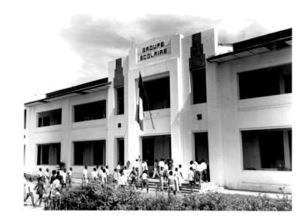
The building of the Groupe Scolaire (Brothers of the Christian Schools) in Coquilhatville. MSC Borgerhout Collection.
All pupils apparently had to sit together in the same classroom. It involuntarily makes one think back to the photographs in image 16. Again, in the report about the school that was composed by the government inspector at the end of 1929, there is still no progress to be reported about the definitive handing over of the buildings. Still, it appears as if at that time they were already being put into use. The inspector wrote: “The school building, the property of the Colony, has not yet been completed.” He went on to describe the building in detail, which indicates that it was in fact already largely completed. Three classrooms, of eight by five and a half metres, were already complete, three others still had to be built. He then reports under the heading “Didactic organization“: “Each classroom has a large blackboard and is furnished with good school desks with two seats.” The three classrooms were populated by the 150 pupils of the primary school, who came regularly according to the class registers, and by the 87 children in the kindergarten, who, however, came less regularly because of the great distance involved.
In this phase the development of the girls’ school was certainly followed up well by the responsible inspectors. The ink on the Jardon report was not yet dry when Vertenten made a new report in February 1930. From this – more detailed – report it can be seen that there were certainly some difficulties during the start-up and that the material infrastructure played a role in some of them. In the first year there were 80 girls. It is true that they did not all come every day but they all sat in one classroom. The teaching assistant found it hard to keep them in hand: “80 pupils is certainly a lot for one classroom and one teaching assistant, who is not even professionally trained. The Reverend Sister Headmistress is doing everything possible but I can understand that she sometimes loses heart. It is absolutely necessary to divide this first year in two but there is no classroom available.“[xvii] In the second grade, which also developed in the meantime, they were confronted with the same types of problems. The two years of the second grade both got lessons from one Sister, Soeur Josephine. She gave lessons in turn to the first year and the second year, always in the same classroom.
Finally, there is an interesting observation in connection with the position of the school, which was built on a strip of ground between the ‘European town’ Coquilhatville and the place where the Congolese lived. As can be seen on the map shown here (p.191), large, grid pattern neighbourhoods developed outside the city centre, where Congolese workers found a place to live. Racial segregation was a fact of life here, too. The only exception must have been the school of the Brothers, which according to Muzuri was housed in the buildings of the Chambre de Commerce, which would normally have been in the (European) centre.[xviii] Naturally, this was an official school, which may have played a part in the assignment of temporary accommodation, until the Groupe Scolaire was handed over. At the girls’ school the distance that the pupils had to travel to and from home seemed to pose a problem, though one of a really ambiguous nature: “With the intention of resolving the distance from the ‘Belge’ and in order to stop too frequent comings and goings we are considering establishing a refectory where a hot meal can be served at midday. In this way they would be (sic) removed for a longer period from their milieu and have more contact with their teachers.”[xix] The suggested solution was typical of the beginning period of mission work in general. The purpose was to separate the children from their environment as much as possible and bring them under the influence of the missionaries. That could only be a good thing, at least according to the Sisters.
The Belge, in this case also called “Coq Bakusu”, was the first city expansion, a neighbourhood populated purely by the Congolese. The girls’ school was certainly established there. The girls therefore seemed to come mainly from the villages around Coquilhatville, maybe also from the military camp in the north of the city. As De Meulder shows, Coquilhatville was much more a loose collection of entities laid down next to each other than a well-considered urban project. A good illustration of this is the description that Paul Jans gave in the Annalen: “On the contrary, the blacks attend well, though the real native village lies a half hour from the church. (…) The misfortune of such villages is that they simply knock them down and replace them as the white city spreads. The houses are made of clay and are erected very quickly. In this way the village has moved so far away from the church that it is absolutely necessary to found a new church, near the village and by the military camp.”[xx] In 1934 a new mission post, specifically for the Congolese neighbourhood, would finally be founded, “Coq Bakusu”, around which the cité indigène would then develop further.
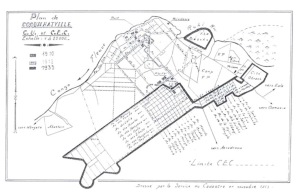
Plan of Coquilhatville, centre urbain et centre extra coutumier, made by the land registry department. From De Meulder, B. (1994), vol. 2.1. illustration 7.33.
Besides the girls’ school there had in fact been a boys’ school in Coquilhatville for quite a long time. From the information given by Corman in the Annuaire of 1924 it could be deduced that there must have been a school there. This must have been a school founded by the Trappists. In one of their publications from that period there was a report on religious education: “When in 1901 the mission began near Coquilhatville, where Bosekya Norbert was a catechist under the first pastor there, E.P. Gregorius Van Dun, many adult people and some who had already being married in the heathen fashion began to come to the lessons.”[xxi] No information is to be found on the material organisation. The vice-governor general Duchesne reported in 1920 in his political report to the governor general that there were certainly some schools in the mission posts but that they did not amount to much. “The said mission has a so-called primary school. One missionary and one or two teaching assistants enthusiastically teach religion, writing, reading, the 4 major parts of arithmetic, a little on the metric system, perhaps a few notions of hygiene and agriculture.” He is as brief as he is laconic about the results of the education: “In general, very few pupils, who rarely complete their studies.“[xxii]
From the travel reports of De Jonghe it can certainly be deduced that the Trappists had started to build a boys’ school: “The school buildings of the Trappists, constructed 2 years ago, include 4 classrooms. The teaching is done by a missionary in the 4th class and by 3 teaching assistants in the lower classes. I have counted around 40 pupils in the 1st year, around 30 in the second, the same in the 3rd and around a dozen in the 4th year. Over the last two years, the Trappists seem to have made a serious effort to provide an adequate school. Their efforts should be encouraged.“[xxiii] In the first inspection report from 1927 there is some information that fits with what Duchesne reported. According to his information the primary boys’ school in Coquilhatville had two years, with 60 and 20 pupils respectively. The personnel indeed consisted of one religious worker, the ex-Trappist Bernard Wiedenbrugge, who was assisted by two Congolese teaching assistants. The mission inspector was very brief in his commentary: “Devoted staff do what they can; the lack of assiduity hinders the general progress; the material could be better.”[xxiv] There was no specific information in this report. The next year the commentary was more detailed and the mission inspector (Vertenten) did not even have enough space to write all his thoughts down. He found that the teachers left much to be desired but also reported that an agreement had been reached between the MSC and the Brothers of the Christian Schools to start up a teacher training college in Bamanya. The government inspector clearly got on well with Vertenten, who had had extensive contact with him when he was appointed mission inspector. He also wrote positively about the future projects of the MSC.[xxv]
It looks as if Bamanya took a very important position in the mission strategy of the MSC at the end of the 1920s. The centre of gravity of education came to be there and in Bokuma, where a junior seminary was already operating at that time. Coquilhatville got no privileged treatment in any way. The decision was made to set up the Groupe Scolaire, inspector Jardon reported in October 1929, and in the meantime the MSC did not find it necessary to do anything about the state in which the classrooms were at that time. They chose to use their money to build schools at other mission posts. However, the situation of the existing infrastructure was not ideal. Jardon wrote: “The school has three classrooms situated in a brick building with a sheet metal roof, whitewashed walls, a concrete floor and bilateral lighting. These classrooms measure 5 m in length by 6 m 50 wide. In addition, a hangar classroom has been used for the preparatory courses, where excessively young children are admitted to follow the primary courses. Very well maintained, the primary school classes are inadequate for the number of pupils occupying them. Moreover, their arrangement is wrong in the sense that they are wider than they are long.”[xxvi]
That only seems to strengthen the hypothesis that the MSC did not want to make the big city a priority. In subsequent years schools were extended at other mission posts. As has already been stated in the first chapter, new schools were also built in the new mission posts. Hardly any information can be found on the erection or the interior equipment of these. The reports to the superiors in Rome are missing for this period (the second half of the 1920s). In Boende (founded in 1926) a school building had been erected very soon but just before completion it had been destroyed by a storm. Marcel Es gave an impression: “The rebuilding was begun with courage. Everything seemed to work against us …. but still we will have one. We then will still need Sisters for the girls’ department – which is now being necessarily neglected – and Boende will be fully recovered. And in the meantime? … Two warehouses; a wood warehouse and a shed to dry stones, which serve as a school: a few posts in the ground and a palm roof on them. If there is rain or a thunderstorm, it is impossible to give lessons; open on all sides, there is continual disturbance from the calling and shouting of the workers that keeps them informed about everything that is happening at the mission. (…) Yes, it sometimes gets still worse and they all sit outside at the drop of a hat (…) One of our school warehouses gave up the ghost recently. In the middle of class, suddenly there was a big crack and I and my boys just had time to jump outside.”[xxvii] Some years later Father Smolders wrote in the same periodical that they had had to sacrifice the school because of lack of space, to give the Sisters a roof over their heads, and that they had held the school (four classes) in the church.[xxviii]
2.3. Functional phase
In one of the last issues of the Annals of 1930 a call to raise funds was made: “Considering the new school law introduced by the colonial governor, our missionaries will no longer be permitted to give lessons in barracks erected in wood or stamped earth but innumerable schools must rise from the one end to the other of this continent, which, as much through their strong materials as through their hygienic improvements and also through the demands that are made on their teaching staff, have to conform with the newly posed legal regulations. All this requires a great deal of expenditure and a fundamental professional training for masters and mistresses, so that the Catholic schools will be able to compete with those of the Protestants and Moslems.”[xxix] This referred almost certainly to the first programme brochure, which was issued in 1929. Obviously, this was a half-truth. It would have been rather more correct to state that there were now conditions attached to the subsidies. But it was of course true that people now needed decent schools, which could withstand inspection. And the importance of the infrastructure in this was not to be underestimated.
A minimal infrastructure was also needed outside the schools because a number of mission posts were rather isolated and some posts ‘recruited’ in a rather extended area. There were many children who had to come a long distance to school and who could not just come and go home. A boarding scheme fitted naturally into striving for immersion, insofar as possible, in the Catholic atmosphere. However, the organisation of this was not always straightforward. In Bokote and in Boende the missions were confronted with a great influx of children, while there was no possibility of lodging all the applicants. Vertenten wrote: “In Bokote they have been able to accommodate most of the children with the families who live there at the mission. There are families who lodge 20 or 30 children. In Boende there are not enough married people to arrange this lodging, above all the tribes are too diverse there. The boarding building is much too small for 600 boys. The boys themselves have erected emergency huts and gradually improved these: huts, larger and smaller, but mostly smaller, with sleeping benches made from branches and one or more fireplaces.”[xxx]
A number of the mission posts were probably more developed, in the sense that more missionaries were active there, that the post had a greater catchment area and that education received more care. This has of course to be associated with the development of further education. Although it should be clear by now that the MSC were not particularly great supporters of further education, there were still areas in which they took part. Strictly speaking this was restricted to only two fields, from which one can conclude that these were inspired by a certain necessity: these evidently were teacher training and priestly education. A teacher training college was founded in Bamanya, where a primary school was already established. In Bokuma a junior seminary was set up, in which a great deal was invested too. There was also a primary school there but the seminary certainly recruited in the whole region. Besides this, education also seemed to be developed further in older mission posts, such as Bokote and Wafanya, and newly established posts, such as Flandria and Boende.
Generally speaking, it seems that a relatively long time passed before the infrastructure was in order. Reports of a lack of space were legion. At the school of the Brothers of the Christian Schools in Coquilhatville moving could take place in 1932: “The construction of the primary school is finally completed. After three years of existence the success of this establishment is assured. Because of the lack of space in the temporary classrooms, the school directors had to limit the admission of new pupils.”[xxxi] According to the inspection report for 1934, there were five classes in the girls’ school in Bamanya but only four classrooms. Because of this the two highest classes sat together. They sat with a maximum of 25 girls in a classroom of 7 by 5 metres. Obviously, giving separate courses cannot have been easy.[xxxii] In the teacher training college itself the situation was similar in the lower years. In the first inspection report he made about this school, Vertenten wrote: “I have established that a single group has been made of two groups of children, the one comprises 19 pupils, the most advanced, and the other the remainder, i.e. 27. The teaching assistant in front of this class is especially concerned with the more advanced group, the others (according to the Rev. Fr. Headmaster) have to get what they can from it.”[xxxiii] There seemed to be too few classrooms to split the group in two, but evidently no effort was made to give the people in the first year a suitable course.
There were certainly a number of building projects in the pipeline but they could not always be carried out as quickly as hoped for. Sometimes Fate intervened, as in Boende, in other cases different priorities were simply chosen. That was, for example, the case in Wafanya, the newest of the Trappist missions. In the inspection report for 1931 it was reported that there was a real rush into the school, particularly in the third year: “It is still necessary to be satisfied with the poor school in adobe. The Reverend Father Superior of the Post, the Rev. Fr. Dubrulle, hopes to start the construction of the new brick school this year. As the old Church is threatened to collapse it was necessary first to build a temporary church. A dispensary and a dressmaking school were essential. The plans for the new school have already been approved by Monseigneur.”[xxxiv] The sewing workshop was apparently more necessary than a proper school. At that time there was still no primary education for girls.
Bokuma, also one of the older mission posts, had a primary school that was led by the Sisters of the Precious Blood. Here, too, they were confronted with similar choices: “It has not yet been possible to construct the new building we consider necessary. The house, which has as yet housed the boarders, is threatening to collapse and other very urgent works cannot be postponed, so we have not been able to think of it yet. As the small classroom is still adequate for the number of pupils we have renovated it and whitewashed it. All the desks and chairs are new, still temporary but solid and easy.“[xxxv] In Bokote work was begun on better and larger classrooms: “In the classroom for the first year of the first grade there is overcrowding of pupils. The construction of a fourth, temporary but solid and spacious classroom is in progress. When it has been completed a fourth teaching assistant will be appointed.”[xxxvi] In other places a boarding school was built, as in Bamanya: “Since I have been here in Bamanya they have built a large school for boys, and another building of 64 by 50 metres. Already 200 boys sleep in it and the beds for the rest will soon be finished.”[xxxvii] And in the new posts the school was immediately included in the planning: “Flandria: one kilometre from Flandria, we have founded the mission of Boteke. A priest is in charge and 3 sisters of the Precious Blood have been placed there to take charge of the school. They already have a good group of girls. We intend to concern ourselves particularly with the Batswa.”[xxxviii]
For the third phase of my hypothesis, therefore, many marginal comments and shades of detail need to be added. The school curricula obliged the missionaries to manage the school in an organised manner. It was never straightforward to get everything financed and subsidies became more and more necessary from the 1930s onwards. The degree to which good results were reached was often dependent on very local circumstances and this can best be illustrated by a few concrete examples. In the following section I will consider the development of the mission posts of Flandria and Bamanya in more detail. Flandria was a new mission post, founded by the MSC, Bamanya was the oldest of the already existing mission posts.
A few concrete examples of central and rural schools
3.1. Flandria (Boteka)
3.1.1. Education for the Congolese
Flandria took a special place among the other mission posts of the MSC for three specific reasons. It was a post that was closely connected to a private company, the Huileries de Congo Belge, and it was also partly developed by Gustaaf Hulstaert, who was head of the school from 1927 to 1933 and from 1947 to 1950. Vertenten founded the mission post of Boteke or Boteka, as it was really called, in 1926. That occurred at the request of the company, which had been present in the Congo since 1911.[xxxix] The company owned the rights to a wide area in the region, where they wanted to produce palm nuts. The Lever company did not acquire the rights coincidentally. Negotiations with the Belgian State had preceded it. This finally resulted in a convention, in which, besides the profit margins for the parties to the contract, the rights and duties of the enterprise were also defined. In this way it was, among other things, determined that education must be provided on every plantation.[xl] The enterprise was therefore contractually obliged to contact the missionaries with the idea of the development of education and the social improvement of the working people. The company was not working on its apprentice piece in Flandria, this is apparent from the way it tackled matters. Vertenten, who as director of the school would also control the infrastructure, received a letter in July 1926 in which he was asked, in the future, to make systematic reports (every four months) about the situation of the school. The letter also specified in detail what kind of information was required: it went from the condition of the building to the names of the teachers, the moral education and the observed influence of the school in the region.[xli]
Later on, the precision and the economy with which the company interacted with the missions were apparent. They did not function as a generous Maecenas but did work as a business partner. An internal memo from the managing director to the district manager in Flandria specified in 1928: “As you are aware, the professional schools of the Société that are managed by the Missions in our different Areas received as a certain Capital Grant for the construction of the school buildings and workshops, dormitories, etc. and now receive an annual sum to cover the cost of the teaching staff, scholars clothing and food, school books, stationery, etc. etc. Over and above this one Capital Grant and the Annual grants nothing must be given to the schools or the Missions connected with them except against payment of its cost price.”[xlii] Another good example was the letter in which the school director was himself asked to make copies of the four-monthly reports that he had to send to the HCB. That would be a significant timesaving for the Huileries in Flandria, “and (we, JB) will be certain of avoiding any copying errors.”[xliii] Hulstaert replied to this, with a similar letter, in which he asked them to always send two copies of their letters, for his superiors. He informed them of one difficulty which meant that he could only send four copies of his letters: “The machine and the paper which I have available cannot make 6 copies at a time.”[xliv]
The construction of the school buildings began in 1928. A lot of people had been involved. Vertenten negotiated for a long time with the management of the H.C.B. about the right location, and the necessary space for the school buildings. In the summer of 1927 he wrote the following: “You require the construction plans for the buildings we intend to build as quickly as possible. That is easier said than done, especially as I do not know precisely what it is you require and I would like to reply adequately to your request. According to the letter from the Rev. Fr. Dereime from 4 March 1927: ‘The government curriculum stipulates that the pupils at the school for clerks eat with place settings, knives, etc. The Adm. Baissel, whom I consulted on this fact, intends to extend the measure to all pupils in school.’ – it is thought that the constructions must be erected in the genre of a college or boarding house. According to your sketch attached to your letter of 14 June, it seems that inadequately spacious refectories have been provided to have two hundred pupils eat with place settings, knives, etc.”[xlv] Vertenten was obviously of the opinion that the easiest solution would simply be that H.C.B. should just define what buildings they wanted and that they should simply appoint a construction supervisor.[xlvi]
In September 1928 Hulstaert, who in the meantime had become the director of the school, reported the following state of affairs: There were four dormitories, which were almost all completely finished. One of the dormitories was used as a classroom because the clay building that had been used as a school was already worn out and thus had been demolished. The building of two houses for teaching assistants was still in progress but they had not yet started on the school building itself. They were still busy with the preparatory groundwork.[xlvii] There was a great deal of discussion about the correct placement for the buildings. Hulstaert would not give way and defended a sufficient distance between the work camps and the location of the school to the management of the H.C.B. He wanted a minimum of 250 metres distance between the two. There was a great deal of disagreement about the correct location of the school buildings. In a report to the State, in early 1929, Hulstaert again expressed his dissatisfaction about the progress: “The correct operation of the school is hindered by the fact that the constructions have not been completed. (…) Difficulties a) material: establishment of the constructions (difficulties in obtaining the ndeles required for the roofing, during almost the entire year; insufficient workforce); b) materials to provide the pupils with the necessary nourishment.”[xlviii] He repeatedly asked for support from the Huileries in the form of transport or materials but the repetitions in the correspondence indicated that people at the HCB were not very receptive.
In the summer of 1929 still not much progress had been made. Hulstaert noted in his report to the company that they had even had to replace the temporary classrooms (“hangars“), which were used for teaching and as a workshop, because they were falling apart.[xlix] In the second half of that year the work did proceed better but they had clearly not yet begun the building of the school itself. There were constant removals because they had to manage with a minimum of classrooms, while the school population and that of the mission continued to grow. The dortoirs functioned in turn as a storage area, a classroom and a dormitory.[l] Again, in the Annals Vertenten reported that two of the dormitories were being used temporarily as classrooms.[li] And in October 1930 Hulstaert wrote yet another note to the management of the HCB in Leopoldville concerning the school building, in which he said: “We constantly have to halt the construction of the school itself.“[lii] In the inspection report written by Vertenten in March 1931 no direct allusion was made to the building problems. That probably indicates that it was not really considered a problem. The only remark in the report that could possibly be connected with the condition of the infrastructure is the conclusion: “An attempt is being made to do the five years of primary school in three years and we have every confidence in its success.”[liii]
In an official inspection report (of the government inspector) that was made half-way through 1929,[liv] the state of affairs concerning the infrastructure of the H.C.B. school was described almost completely: “Four dormitories for boarders, each comprising two rooms of 12 metres by six, have been constructed. These are brick buildings with a concrete floor, whitewashed walls, sheet roofing, with bilateral lighting. While awaiting the final construction of the school, one of the two rooms in these buildings will be used as a classroom. These rooms are perfectly adequate. The final plan for the school has been given to me. The installations – primary school and vocational subjects – comprise 7 classrooms: one of 10 m, 50 by 6 m, 40; four by 8 metres by 6 m, 40; two by 6 m, 40 by 5 m, 25. The school will be built in brick and covered by sheet metal. The ground of the buildings will be concreted.” Subsequently, the building programme yet to be completed was unveiled. From this it was apparent that at that moment there was still reckoned to be 18 to 24 months before work on the school would be commenced. The priority was given to the further completion of the dwellings of the European staff (the missionaries) and the remaining provisions for the pupils. It was reported that there was already a kitchen, as well as two dwellings for teaching assistants and a “fosse à fumigation suffisante pour 120 hommes“.[lv] Besides this the report also mentioned a jardin d’essai, which, in principle, was obligatory for all primary schools according to the 1929 school curriculum. Incidentally, “Cultures faites par les élèves” were also reported so that it may be deduced that two different things were truly meant by these references. In any event it was a fact that the pupils were engaged to provide their own living provisions and those of the mission post. They also had to help with the building work. The missionaries considered this a good practical training. Hulstaert declared in a letter to the manager of the HCB: “With regard to using the pupils for light works to be carried out over a part of their time I have the honour of informing you that we have done the same since the very beginning. It is moreover an educational element to accustom them to manual work from a young age.”[lvi] In 1935 the new manager, Trigalet, reported, not without a certain pride: “From a point of view of agricultural work, the upkeep for 40 Ha plantation of Elaïs (palm plantation, JB) is left to the care of our pupils.”[lvii]
One of the biggest problems with which the missionaries were confronted at the post was the provision of food. It was apparently enormously difficult to continuously deliver food for a large number of boarders. The mission post itself had limited ground: “Surrounded from all sides by huge plantations of the H.C.B., the school only has very restricted land available. The buildings and the various subjects take almost all of it.”[lviii] Hulstaert also had discussions with the HCB-management about the provision of food. What the food for the pupils should be allowed to cost was worked out to the centime. According to the H.C.B. it was agreed that for each pupil, each day, one franc was paid for buying food. The government inspector, Jardon, had made remarks in his report about the insufficient rations for the pupils. According to the general management in Leopoldville the allowances were enough. The missionaries must have made agreements with the territorial administration about the delivery of food by the population from the surrounding villages. And they must have developed and expanded the cultivation by the pupils, so as to have sufficient food supplements.[lix] Hulstaert reacted to this a few months later in his typical, detailed style. At the same time it gives a good picture of the sort of provisions available for the pupils:
… Quant aux chickwangues, nous les achetons également ici aux magasins de la Société.[lx] Elles nous sont facturés 0,2795 fr. pièce. Elles ne pèsent pas 1 kg. mais leur poids moyen est de 440 gr. seulement. Et nous constatons encore une tendance à la baisse du poids. En outre il nous est souvent impossible d’avoir la quantité nécessaire. Ainsi pendant le mois courant, nous n’en avons pu obtenir que 200 par semaine, alors que le nombre des élèves dépasse 100. Nous nous voyons donc obligés d’en acheter ailleurs. Or le prix de faveur est de 1 f. les 3 chickwangues.
Je me permets de vous présenter ici deux schèmes faite sur cette base, avec les prix minima et maxima. Les quantités indiquées ne me semblent pas exagérées, vous en conviendrez également en comparant la somme allouée et le prix des vivres tels que vous les indiquez.
See Illustration
Permettez-moi de vous faire remarquer encore que les prix des chickwangues tend à une hausse; les indigènes commencent à exiger 50 centimes pour une seule chickwangue. Ensuite le riz ne saurait pour les gens d’ici remplacer le manioc qu’en partie. D’ailleurs il requiert une quantité d’huile plus grande à cause de la préparation.
Les schèmes n’indiquent pas de légumes etc. vu que les élèves peuvent les cultiver eux-mêmes. Mais la préparation exige de l’huile et une rétribution pour les femmes qui s’en occupent. Cette rétribution est de 0,0193 à 0,0194 f. par élève et par jour. Plus tard il faudra un cuisinier, ce qui augmentera les frais de préparation d’à peu près 2 centimes par élève et par jour, le tout calculé sur la base actuelle de 100 élèves.
… Nous étendons les cultures faites par les élèves, mais le temps et le terrain mis à leur disposition ne permettent que la culture de quelques vivres supplémentaires, comme des légumes, des condiments, fruits, etc.
Excerpt 1 – Gustaaf Hulstaert about the cost of living (1929). Aequatoria Archives.
At the end of his letter he gave another explanation for his extensive and detailed account. He said it was a very important element in the correct functioning of the school. If the provision of food was not in order, the teaching hours also suffered because the pupils had to take care of it themselves. Providing their own means of survival necessarily had a detrimental effect on the time that could be spent on the lessons and consequently on their intellectual training.[lxi] The conclusions by Hulstaert correspond exceptionally well with the memory of one of the interviewees, Jean Indenge, of his time at school in Wafanya during the forties:
La mission, ou l’école organisait des repas. Mais, de quel repas s’aggissait-il? Je vous dessine un chikwangue … Alors, là, c’était cette forme. (he draws a sketch, JB). C’étaient les femmes qui venaient de loin, qui vendaient ça aux missionnaires pour les élèves.
Alors, quand on revenait de la messe, à 7 h. du matin, on recevait chacun un quart (montre sur le dessin). Un petit morceau comme ça. C’est du pain. Mais c’était insuffisant pour un garçon qui devait étudier, et qui devait (fortement) travailler comme un militaire, pour ne pas dire comme un prisonnier.
Alors, ce chikwangue, quand ça datait de plus d’une semaine, ça produisait déjà des champignons. Je suis très content que vous m’avez posé des questions là-dessus, et j’aimerais bien voir un ou une missionnaire qui va me contredire sur ça. Parce que moi, j’étais là, je ne raconte pas ce qu’on m’a raconté.
Donc ce n’était pas suffisant. Alors, on devait manger quoi? Parfois il n’y avait pas autre chose. Parce que si nous attendions le dimanche, ou le soir, nous avions la même chose, plus des petits morceaux, j’ai oublié comment on appelle ça, de peau de cochon. Ils étaient grillés, et on les coupait en petites rondelles, comme ça. Et, parfois le dimanche, on recevait un demi chikwangue au lieu d’un quart. Ajoutez à ça comme légume des petits pois prépares, il y en avaient même qui ne voulaient pas manger ça, quand ils voyaient ça, ou avec un peu de riz. Donc, on sentait simplement l’odeur de viande, mais ce n’était que ce petit morceau, je ne sais plus comment on appelle ça. (“makala“) [lxii]
The letter Father Dereume, head of the HCB school in Alberta, wrote to Hulstaert in 1948 is very intriguing in that context. Boys from the school in Flandria were sent to Alberta with the intention of continuing their education there. But apparently it was difficult to get used to the regime in Alberta because the boys already caused problems after one week. One of the reasons the pupils gave for this was the food: “This morning a group of four boys came to me to tell me they were hungry. They are given the same food as the other boys including those who have come a long way and have no family here. Our boys are all well built and are regularly examined by the doctor, so there is no lack of food. It is not surprising they probably are rather homesick, the eldest who was in Kisantu is trying to convince them of that and we hope that he will succeed. But they are rather demanding: they had 100 grams of fish FOUR times a week in Flandria and meat on all feast days, that is probably not exactly true (sic), our boys do not and could not get that.”[lxiii] Hulstaert himself did not worry too much about that, as he made clear in a letter to the directors of the company. He wrote that he was aware that the Nkundo were rather picky and had also made the same complaints in other schools.[lxiv]
3.1.2. Batswa school
Flandria and the mission post at Boteke were in a region where a large number of Batswa lived, a population group that drew a lot of attention. The Batswa distinguished themselves from the rest of the population by their stature and their lifestyle. They were ‘pygmies’ who formed relatively closed communities. According to the missionaries their lifestyle was even more primitive than that of the Nkundo, who were considered the ‘ordinary’ inhabitants of the Tshuapa. The pygmies were an irresistible attraction for the missionaries. Already in 1922, in other words at a time when no MSC were in Africa, Father Es gave a lecture at the mission seminary about the pygmies. He described the essential characteristics of the pygmy: “The ornamentation of the body and mutilations of all kinds are little known. They dress minimally, do not work more than necessary, in other words not at all, live from the hunt, live in caves or behind a windbreaker or in a house built in 20 minutes used for one night and then abandoned. It is also necessary to work for pottery. Consequently, it is not surprising that these outstandingly lazy people have none: all they have, and they are proud of it, are the woods with their game: they have terrible eyes, their legs are as strong as iron and as flexible as rubber, a bow and arrows and to top it all a (…) trust in Providence. (…) They have a philosophy of common sense for everything they do and for this they are able to become independent from circumstance.”[lxv]
This description was characterised by a form of oversimplification that can also be seen in articles on the Pygmies that were published in the Annalen. In 1942 the following statement could be read there: “The Nkundos dominated the Batswas. The missionaries and sisters themselves also despised the Batswa’s: they are dirty, stink, do not wash their children.” The account by father Wauters in 1935 was slightly more detailed but still clearly aimed at readers in Belgium. Wauters emphasised the fact that the Batswas and certainly the Batswa children hated a settled and ordered life. They much preferred hunting and running around in the woods. Sitting still in a classroom was asking a great deal of the children. He greatly emphasised the ‘wild’ aspect (in the sense of ‘not calm’) of all their activities.[lxvi] Around the time that Wauters’ article was published, Van Goethem also wrote his annual report of the MSC mission that has already been cited, in which he paid a lot of attention to the Batswas. In it he quoted two reports drawn up by the same father Wauters on request of the vicar. Wauters considered the method for converting the Batswas and the general condition of the Batswa population: the location of the villages, the outlook of the villages (“lamentable“), their mentality, which was defined as ‘driven by fear’ and characterised by an inferiority complex in relation to the Nkundos. In addition he also described them as dirty, without any sense of hygiene and victim to all kinds of disorders, from venereal diseases to skin problems. He also described the relationship between Nkundos and Batswas, which was apparently a master-slave relationship. According to a certain tradition the Nkundos exercised mastery over the Batswas and obliged them to carry out a number of duties.
Naturally, it is interesting to compare the explanation he gave here to the text published in the mission periodical. Obviously, these reports were, due to the nature of the text, much more elaborated and much richer in detail and nuances. For example, the psychological element and the relations with the Nkundos were considered much more deeply, something that could not be found in the popularising literature. From that angle it is very educational to study more carefully the text dedicated to the pygmies in the textbook Buku Ea Mbaanda, which Hulstaert prepared at around the same time for use in the Congolese schools: “All the pygmies are very intelligent at working in the forests. They do not make mistakes during the hunt, they know the ways of all the animals, they do not get lost in the forests. Like riverside residents are in water so they are in the forests. They only live in the forests. The pygmies do not have any fields, they do not care for their houses and yards, they do not wash their clothes. They only live in the forests with what they find there. They live in their own way. They do not seek intelligence and pleasure very much. The pygmies are not polygamous like the tribes in the Congo. In this way they have been applying God’s laws since the beginning of time, that one man has one wife. Many do not have the ability to be polygamous because of a lack of funds. When the church arrived in the Congo to teach people the way to Heaven, the pygmies did not want to believe it. Perhaps they will believe afterwards. But at the moment they move and wander through the forests. The State has evicted a large number of pygmies, for them to live in the streets. But they are not yet accustomed to living in villages and often return to the forest. They have not yet abandoned their custom of flight. They are very negligent in matters relating to God and the world.“[lxvii]
This is based on the conclusions that Wauters made in his reports and the points of action he formulated in relation to the Batswas. He assumed that the missionaries could intervene in the pygmies’ lifestyle and make them completely ‘sedentary’: “It is necessary to make the Batswa people, who are essentially hunters, into an agricultural people. The Batswa are healthy, vigorous and strong people; they are suited to agriculture and it will safeguard the future of this tribe.” That was the role of the missions. For its part the State had first and foremost to reduce the taxation on the Batswas, as they had also already done so in the Kasaï province. The State also had to encourage them to build houses in loam instead of the straw huts they lived in. According to the priest the blame for this was partly the Nkundos who prohibited the pygmies from building solid residences. But most importantly schools had to be established and more particularly an agricultural school and a craft school. Both were to be used as aids to make the Batswas sedentary.[lxviii] Father Wauters’ ideas concerning agricultural education at least continued to burn for a long time with the MSC. Apparently, attempts were continually made to have the boys learn agriculture at school, which was not an obvious matter for a people that lived from the hunt. In 1945 Hulstaert congratulated the people of Flandria with the results they had achieved in this area.
There was definitely a Batswa school in Flandria. It is not always as clear what school is being mentioned when checking the courses. Van Goethem was also rather unclear in his annual report for 1934-1935: “The Huilever continues to provide the upkeep for one hundred pupils. There are 350 in the school. Evening courses are also taught there to which 48 assistants attend. At the mission post in Boteke, which is in addition to the School Group from Flandria, we have a boarding school for Batswa with one hundred and thirty pupils. We have succeeded in inculcating serious discipline in this timid and wild people.”[lxix] Whether there were also actually two schools is unclear from this. In an article published in 1954 in De Toekomst, one of the periodicals of the seminary students, it was claimed that the mission at Flandria was actually made up of two sections. The first section situated at the HCB concession, with a church, a presbytery and other facilities, including schools. The other part was ‘the mission post itself’, where more functions were clearly housed: “church, presbytery, convent and girls’ school, sewing room, kitchen, laundry, stables, further on a smithy, carpentry, brick ovens, palm and coffee plantations.” That seems clearer, if it were not that furthermore the text mentions that father Wauters had founded a Batswa mission, in addition to the Nkundo mission, that the Batswas had their own school and moniteurs and that another new Batswa school was founded in 1950, subsidised by the State.[lxx]
A remark in a letter by Hulstaert, from July 1946, gives some clarification. The letter is precisely related to the management of the Batswa school and the effect of it on the subsidies to be allocated. The missionary-inspector (who succeeded Hulstaert in that position) had proposed making the headmistress of the girls’ school also the headmistress of the Batswa school. Hulstaert, who had himself just become the head of the HCB school and rector of the mission, wrote: “For the official inspection, however, it is unacceptable for one person to be the head of two schools. This is also impossible in practice. The same case would however also arise if I should take on the school; in fact it would then be even worse because it is even more work than it would be for Sr. Imberta. The only difference would be that in her case the reports would have to mention her both with the girls and the boys, while the HCB school is not stated in the reports and consequently is not noticeable there.”[lxxi] The HCB school consequently fell under the category of a private school and was not in the system for subsidies.
Frans Maes, who worked in Flandria from 1948, indicated that, when he arrived, there was only a boys’ school ‘at the compagnie’. When asked for a summary of the school situation, however, he said: “(There was) a primary school on the site of the compagnie, just for boys. At the mission there was a school just for Batswas, not for others. With three yearly levels; and a few from the fourth or fifth year came to me. That was the case until ‘55 and ‘56. Then two years were merged into one because the school year was then made the same as in Europe. A girls’ school was also built at the mission, in ‘51 and ’52, which the sisters cared for. Everaert built it, he had also built the mission, in white brick. Consequently at the end there were three schools; the one for the Batswas only existed until ’54, I think. They then came to me at the compagnie.”[lxxii] That seems to confirm that the mission school was intended for the pygmies from the beginning and that the building problems discussed extensively here relate to the same school.
In his inspection report from 1939 on the Batswa school Hulstaert did not mention the material problems in more detail but did mention the subsidy problems. He particularly feared that the school’s subsidies could be threatened due to the irregular attendance of the Batswas. Nevertheless, there was a boarding school connected to the school. That did not appear to be very effective because the pupils would sometimes disappear for many weeks.[lxxiii] It seems that the educational project with regard to the Batswas was taken close at heart by the MSC. At the same time, however, they believed that they should be approached differently. In the same way the Congolese related to the whites, the Batswa related to the Congolese. Hulstaert: “Of course a school for the Batswa will not reach a high ‘academic’ standard in a few years as is the case for the schools for Baoto, nor is that expected. The main thing is that the boys are given a proper education, adapted to their ethno-social nature. (…) One must not be as demanding as elsewhere. The aim must not be set so high.”[lxxiv]
It seems that the school was in fact closed for a while because in the correspondence between Hulstaert and the head of the school (presumably father Cobbaut)[lxxv] the question of reopening is mentioned. Apparently, transferring the school to Bokatola, a few hundred kilometres south of Flandria, where the MSC wanted to found a new post, had been considered: “Thank you very much for your last letter. In relation to it and to my letter nr I.568, I would like to inform you that Monseigneur does not agree with my idea of keeping the central Batswa school in Bokatola. In his opinion it must remain in Flandria and under your management. So please consider my proposal as non existing. I hope that the re-establishment of your school proceeds well. I would especially recommend an experimental garden, as undoubtedly something could be achieved with that people in agriculture.“[lxxvi] Moreover, the plan for the mission post was never realised. At the end of 1943 the head wrote a letter to Hulstaert in which he proposed reopening the Batswa school, which indicates that it had been closed at least during 1943.
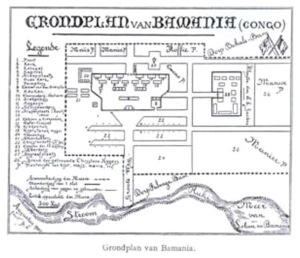
Drawing of the floor plan of the Bamanya mission, anno 1901. From Het Missiewerk in Belgisch Congoland, 1905.
3.2. Bamanya
3.2.1. Introduction
I have already stated that Bamanya was considered by the MSC as the “jewel in the crown” of their Congo mission. The village was the oldest Catholic establishment in the region, founded by the Trappists in 1895. Education was also given there, although this was certainly very rudimentary until the beginning of the First World War. The ground plan that was published in the Trappists’ periodical in 1901 did not show any educational infrastructure. It is also apparent from photographs, as shown in chapter 3, that not much more than religion lessons were given in the church. However, both sources only allow conjecture on the real situation. In the Annales Aequatoria from 1990 a (posthumous) article was published which had been written by Hulstaert on Bamanya in the ‘olden days’, in which he wrote down memoirs of the way Bamanya looked at the arrival of the MSC.[lxxvii] He referred on numerous occasions to a plan published in 1910 but that proves to be the same as that from 1901. However, in relation to that plan he already mentioned a great number of changes. Amongst others he described the school buildings: “The building that is currently still located to the right of the former abbot’s residence or common room, but a little to the front and in a perpendicular direction, was the first school for teaching assistants-catechists, run at the time of my arrival by Fr. Georges Lefevere (transferred to Mondombe in November 1927). The classrooms were situated at the bottom; the attic served as dormitories for the students who ascended there using an outdoor ladder.
… Later it was used as the primary school classroom and then as a room for M.S.C. youth foyer“[lxxviii] He continued with some explanations about the construction of the primary school itself: “Parallel to the latter construction there is also a building with temporary classrooms for the primary school. It was demolished when the new one, which is still standing, was built by the lay builders employed by the Vicariate. More to the left, in the direction of the Bonkele marsh, the plan mentioned above shows four rectangles, the no. 21 indicating the brickworks, which still served for the construction of the final school buildings in the 1930s.” Consequently, the school was also started here before there were decent buildings. The Brothers of the Christian Schools already came to Bamanya at the end of the twenties.
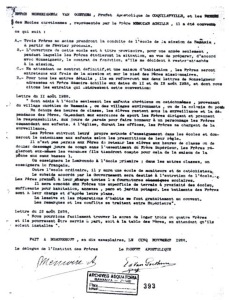
Agreement between the MSC and the Brothers of the Christian Schools concerning the formation of a teacher training college for the Congolese in Bamanya, 5 November 1928. Aequatoria archives.
In a letter of 8 January 1929 Vertenten, who was the mission superior at that time, wrote to the Frère Visiteur that he had not expected that the arrival of the Brothers would be arranged so quickly and that he would try to have all the necessary measures taken as quickly as possible to allow work to start. Apparently, buildings had already been provided at that time for the primary school classrooms because they were not mentioned, unlike the school equipment, for which there was still a great need. The teacher training school, however, still had to be built and he did consider that in detail. The Brothers had ensured that the government had allocated a considerable amount in subsidies for this school. The Brothers’ house and the classrooms were to be built in bricks made on site by the MSC (the brickworks were also mentioned on the old plan of the mission post). The actual building works would then only begin once the Brothers had arrived and approved the design.[lxxix] Nevertheless, the rector hoped to have completed the work around the beginning of March. That it did not progress so well in reality is apparent from another letter from September of that year in which Jans mentioned the material and workforces for the construction of the Brothers’ rooms. This presumably related only to the private accommodation of the Brothers, for which they were themselves contractually responsible, although the MSC helped them with the organisation. The school buildings were presumably were finished faster.
In his inspection report of 1930 Vertenten noted that a large boarding school had been built, intended to offer accommodation to 200 pupils. In addition the furniture was still being worked on: “We have produced a number of new benches and desks, which are very good although temporary. It has as yet been impossible for us to produce model and final desks.“[lxxx] Van Goethem added a little more in his annual report on the mission in 1931: “A colony for boys has been built, with three hundred beds, a sanitary installation, and a health centre.”[lxxxi] In 1932 he wrote a contribution for the mission periodical of the MSC, in which he was clearly proud of the results achieved after three years. He reported that the first teaching assistants had graduated, eleven in total. He was full of praise for the Brothers: the difference to the past was considerable. He claimed that at that time around 300 pupils, all boys, were at school, of which two thirds were boarders.[lxxxii]
Vertenten’s comment on the contrast with the past was certainly accurate. The division of the school into a school for girls and one for boys was only introduced after the Brothers started their work. The girls’ school and the kindergarten were initially next to each other on the same site. According to the 1933 report there was certainly sufficient space and equipment for the kindergarten: “Two rooms have been allocated for the kindergarten, the larger room 5 x 13 ½ m, with 3 large windows and a small adjacent room.” The primary school accommodated 96 pupils, divided over five years. However, there were only four rooms for this. The two higher years were consequently taught together by a Belgian sister, while the other years were taught by a teaching assistant. In the 1934 report further details were given of the outlook of the school. The classrooms were all in stone, a few with a concrete floor, others only with a clay floor. They measured between 35 and 48 square metres and had windows on both sides with white curtains as sunblinds. The pupils sat at the school desks in threes or fours. In addition sister Auxilia also mentioned boards, cupboards and chests as school furniture and “the elements of the metric system, charts, catechism and bible pictures” as “documentary equipment”.[lxxxiii] The inspector reported that the classes were orderly and clean, each pupil had his own pencil case. In his 1936 report Hulstaert did note in passing that the school desks were not really a blessing for the children: “Despite the unfortunate design of the desks, more care should be taken of the children’s posture (when writing, JB).”[lxxxiv]
How the girls’ primary school had developed was indicated in a report from 1938. At that time it already included five years, divided over two grades. The fact that the girls’ school had also developed that well indicates that Bamanya truly had become an important centre for education. As a good example of how decisive the 1930s were for the development of education: in April 1929 the girls’ school was founded, comprising three years. From February 1931 there was a complete five-year structure (divided over two grades). That was also confirmed in the report by Van Goethem for that year.[lxxxv] In the following year a domestic science school was also started but apparently it did not take off initially. Van Goethem explained this as follows: “For the year 1935 the school of Bamanya proposed organising a 6th year, followed by 8 girls, who would follow courses in religion, reading, writing, arithmetic, French, drawing, women’s work: cutting, dress-making, embroidery, knitting, crochet, pottery, etc. in addition to domestic science. This is the second attempt of this type, which apparently is more promising than the first because the pupils are younger.“[lxxxvi] In 1935 the domestic science department was reopened and from 1937 comprised three years of study.
3.2.2. The 1940s
More information on the development of the schools was given in a few inspection reports from the 1940s. The following was reported on the boys’ school in 1944: “The situation of the buildings leaves much to be desired, particularly the old school, the roof of which is in a dreadful condition. The pisé-de-terre construction classroom that serves for the first year has become dilapidated. Fr. Rector has his hands so full with all kinds of imposed and extremely urgent works on buildings that he cannot find any means to do up the school classrooms, although they really need it. This condition of the buildings stands out sharply from the carefully tended flowerbeds beside the school.“[lxxxvii] Which points again to the work that the pupils did at the mission post. The report also considered the experimental gardens, which were still the pride and joy of the missionaries. In 1946 Hulstaert also repeated his complaint on the condition of the buildings: “The building for the teacher training college is very satisfactory but the buildings for the primary school, especially the first year’s classroom that is truly dilapidated, should certainly be improved.”[lxxxviii] In the same year the missionary inspector wrote about the girls’ school: “The school building has undergone a remarkable change: it has been given a zinc roof, unneeded door openings have been closed, everything has been beautifully whitewashed and painted. However, an attic is still needed urgently because it gets unbearably hot immediately under the roof around noon and especially in the afternoon.”
One year later the state inspection drew up a more detailed report on the Sisters’ school. The report included the drawing of the school buildings shown here. In addition it also considered the condition of the furniture. The classroom furniture was in order but the dormitories were not as acceptable. There was only one dormitory where mosquito nets were provided and then there were still too few: “There are only 6 mosquito nets for the eleven pupils who sleep there, which clearly results in deplorable promiscuity.” With regard to didactic material, there was also a shortage, especially for the youngest. The sisters had ordered school boards and some tables and chairs for the domestic science school. In addition, there were only two toilets for 131 pupils, which seemed rather limited to the inspector. In any event, it meant that the terrible smell around the toilets was unbearable, as no septic pit had been installed.[lxxxix] The inspector had apparently also made remarks about the boys’ school, on deficiencies in the classrooms and dormitories: “The rain leaks through the ndele roofs of the two said buildings, causing damage to the rooms themselves and to the school furniture. It is almost impossible to teach in these rooms on days of heavy rains.”[xc] The dormitories stank. Although these rooms were very close to the marsh, there were also hardly any mosquito nets there. The inspector also made a vague allusion here to the damaging consequences for the boys: “The few pupils who have a mosquito net invite a few friends to spend the night with them, which is, especially for the boarders, something which is not advisable.”[xci] Why that was the case was not mentioned.
The school head, Father Wauters, responded in a particularly irritated way and wrote a letter to Van Goethem in which he parried the criticism from the state inspection. According to him the inspector had smelled the manure from the cowshed instead of the toilets. However, he did implicitly admit later on in the letter that he was right but attributed that to the unwillingness of the Sisters to move the toilets to a more remote site. He naturally also had to react to the remark relating to “promiscuity“: “Mr. Van Meerbeeck obviously comes from a family with only a few children otherwise he would know that brothers and sisters from large families in Belgium always sleep together. I have never heard those families complaining of ‘deplorable promiscuity’.” He even added a few gibes at the inspector: “If the Department of Education would like to compensate the expenses, I am naturally immediately prepared to buy iron beds for all the children. In addition I have also ordered 500 mosquito nets for the boys and girls at Bamanya. Once they have arrived they will be handed out for use, in the hope that the Department of Education will pay for them.” Furthermore, the Father did not give the impression that he had fundamental problems with the material condition of the school. He thought that the schoolchildren in Bamanya were accommodated much better than in their parents’ houses, which constituted an improvement to their life. He finally also took a swing at the government: improvements and expansion of the building had been discussed for some time but if the state, with all its means, did not succeed in providing some infrastructure within a short period, that was even more the case for private parties, especially as it was difficult to find good workers. It is clear that the priest had to confirm nearly all the inspector’s arguments, no matter how much he tried his best to find counter arguments and excuses.
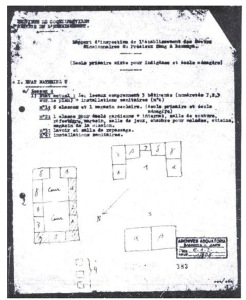
Drawing of the school of the Sisters of the Precious Blood in Bamanya. The captions with the drawing: no. 1: brick building, covered with corrugated sheets, with six classrooms in one school building, no. 2: one classroom for the kindergarten and boarding school, sewing room, dining room, storeroom, playroom, infirmary, kitchen and the mission storage place; this building was rectangular and had an inner courtyard divided into two separated parts; the building was constructed in brick and was partially covered by corrugated sheets, the other part in ndele (shaded). no. 3: laundry and ironing room, also built in brick and covered with ndele. no. 4: toilets. From the report by the state inspection for 1947. Aequatoria Archives.
3.2.3. The 1950s
In the early 1950s the girls’ school was made up of a U-shaped building complex, including six classrooms, probably of 8 by 6 metres. The flooring was concrete and the roofing zinc sheets. Four rooms served as classrooms for the lower grades, two as classrooms for the domestic science department. The kindergarten, which was also integrated in that complex, comprised a single room of 14 by 3.5 metres. There were windows on two sides throughout (“sufficient lighting and ventilation“). The children in the kindergarten sat at small tables and chairs, in the primary school long benches were used and in the domestic science school the girls were given a table and chair. The teachers had a desk and a chair available and taught using a school board, made from wood or cardboard.
The boarding school comprised 3 dormitories, a dining room, a ‘native’ kitchen, a workroom, a sitting room and a storage area. The building was entirely constructed in stone. The flooring was made partially from concrete, partly from terracotta (e.g. in the kitchen) and the roofing was partly zinc sheets and partly ndele. Electric lighting was a major innovation for the evenings. The condition in the boarding school was apparently considerably improved now. The pupils slept in wooden beds or beds made according to the model used in the boys’ school. Each pupil had a mosquito net, a native mat, a blanket and a pillow. There was a chamber pot for every two pupils. In addition, the inspection report of 1950 also stated: “The pupils sit at tables in the dining room covered with a clean table cloth and on benches. Each pupil has a plate and a spoon. In addition there are bottles with clean drinking water on the table, with an enamelled drinking mug per two pupils. The dining room is completely clean and looks especially pleasant in its simplicity.“[xcii]
The report stated the following about the boys’ school: “The first year is established in a room in the boarding school. It is made from durable materials, is covered in sheet metal and the floor is in terracotta. The 2nd, 3rd and 4th years are established in a separate building opposite the Brothers’ house; two of the rooms are 9m x 5m and one is 7.5m x 5m. The whole is constructed in durable materials, with a concrete floor and a roof in ndele, but its outer appearance has changed a lot since last year (…) The 5th and 6th years occupy two classrooms of 7m x 8m each in the normal school complex, which is also made from durable materials, with a concrete floor and sheet metal roof.” There was sufficient lighting and ventilation. According to the missionary inspector a few rooms could do with a coat of paint but except for that everything was in very good condition. In addition, he also mentioned the presence of a small workshop for handicrafts and a few hangars that were used as a brickworks: “In one the earth has been worked and bricks are made from wooden moulds, the other is used for drying the bricks and the third houses the oven where the bricks are baked.” This was consequently also considered a part of the school, although everything points to the missions also trying to earn some money from this by supplying buyers from around the mission posts with bricks.
The boarding school was made up of a separate complex, with an inner courtyard and four dormitories of 24 by 4 metres, a large dining room of the same dimensions, a room of 12 by 4 metres that served temporarily as a classroom (for the first year), two rooms for the Père Surveillant, two storage places and half-open hangars where the children could ‘relax’ and cook “à leur gré“. From the remarks of former pupils it may be deduced that the voluntary aspect of this sometimes had to be taken with a pinch of salt and that the hangars pretty much served as the permanent living area for the children. The beds were made from wooden planks that sloped slightly and that were supported by some bricks. There was a mosquito net for every bed, a mat and a blanket.
Every pupil had a place at the table, a chair, a plate and a spoon in the dining room. The sanitary facility had finally been replaced: “12 installations in durable materials and with a concrete floor have replaced the old portable sheds this year. They are very well maintained but more ventilation at the top would better ensure the elimination of all disagreeable odours.”[xciii] The school furniture included long benches which were old-fashioned (in the inspector’s opinion) and that should be replaced by modern models. More modern pairs of seats were used in the highest classes of the primary school.
In 1951 the report of the missionary inspector did not go into details with regard to the infrastructure. It was simply stated that the changes that had been started at the end of the 1940s had unfortunately not been continued.[xciv] The 1952 report again considered the material aspects of the boys’ school in detail. Strangely enough Moentjens, who had been rather positive about the school in 1950, gave a very detailed but relatively critical report: “All the classrooms are in good condition but the periodic upkeep of the classrooms leaves much to be desired. The layout of the benches themselves sometimes gives an impression of disorder. The 2nd, 3rd and 4th primary classes are too small for the current number of pupils. (…) Unfortunately, the impression of the interior appearance of the classrooms and the furniture is nothing to be proud of in either of the two schools. Almost all the primary school rooms are too small. It would be a major and greatly beneficial improvement if a headmaster’s office and a reception be added in the new secondary school building so that the head would no longer be obliged to receive people in his own residence.”
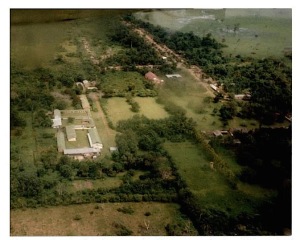
Aerial photograph of Bamanya, in the 1990s. The buildings of the Sisters of the Precious Blood are to the bottom left, the church and parish hall are in the centre, with the village above. To the right, under the river (a tributary of the Ruki), is the former boys’ boarding school with the residences of the Fathers a little further down on the left, where the building of the Aequatoria research centre is also situated, hidden from sight by the trees. MSC Borgerhout Collection.
He was equally critical of the furniture: “That (the furniture) of the 4 first primary years is not worthy of a central application school as Bamanya.” The boarding school was also too small: there were only 196 beds for 208 boarders. Apparently, not much had happened during the two preceding years. Although it was clear that certainly not everything was in order, from the remarks given here it may be deduced that the standards used for evaluation had also shifted somewhat and that the condition of the school had certainly not deteriorated in general. An illustration of this is the plea by the inspector for a school museum: “It would be interesting and useful to organise a school museum of indigenous objects and a collection of colonial products.”
The school for moniteurs was finally the basis for a ‘higher’ teacher training college in the early 1950s. Its construction took a number of years. In the annual report for 1953 Vermeiren already noted that there were seven new classes, an office and a school museum. New sanitary installations, dormitories, a kitchen and dining rooms were in progress. At that time, work was also finally complete on the girls’ dormitories, although no further explanation was given for this in the report. The statements of the vicar make it apparent that the situation in these dormitories was initially not too good: “One had to renovate the girls’ dormitories and the stables and one had to build numerous houses in durable materials for the teaching assistants and workers.“[xcv] The attention in this type of reports was usually primarily paid to the projects pending and the progress that was hoped to be gained. The fact that this point was situated right at the end of the text is consequently also indicative of the importance attached to it. The construction of the teacher training college and its completion was really the only point worth mentioning in the reports for the early 1950s. The opening of the school and the completion of the building were already mentioned in 1954. However, it was considered in detail again in 1955. Presumably the vicar also had his own sales tactics. The construction of a new domestic science school was also mentioned in the years 1954-1955 and in 1958 the completion of new school buildings for the primary school in Bamanya was also reported. Whether this also means that there was a complex of school buildings is another matter. When the number of pupils is considered next to this, it seems that these all related to relatively small groups which probably did not take up too much space.
3.2.4. Les champs scolaires (the school fields)
In the inspection reports a lot of attention was paid to what took place outside the classroom: the garden, animals, workshop. Work on the land is discussed in every report. In Bamanya the children had experimental gardens available and they also maintained the Brothers’ orchard. In one of his reports Moentjens even wrote: “In a purely material field nothing has changed since the last inspection except for moving and expanding the school fields“, to which he added: “A curious matter and one with which I am unable to agree completely is that the products of the school gardens are sold whereas they could be used to feed the pupils themselves.” The mission post also had a real farm: “The school itself does not have the facilities for livestock farming, but the small and large livestock of the mission indirectly served for teaching and the Brothers’ henhouse is looked after by the pupils.” In 1938 a separate report was even drawn up about the ‘experimental garden’, in which the content of the lessons was described and the way in which theory was converted into practice. The pupils also had all the time necessary for that because the report concerned also mentioned the duration of both types of lesson: “Theoretical 30 mnt. a week. Practical 7.30 (h.) a week.”
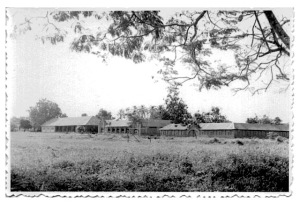
Bamanya, in the 1950s. From left to right the Sisters’ residence, the domestic science school and the girls’ boarding school. MSC Borgerhout Collection.
The 1950 report also included considerably more on the champs scolaires, the petit élévage and autres travaux matériels than on the other material aspects of the school itself. It included a list of the works carried out by the various classes: “With regard to handicrafts and other things imposed by the curriculum, here is a brief summary of what was carried out:
1st A: weaving raffia cords; 2nd, 3rd, 4th and 5th raffia lace-making; the five first years of primary school: wickerwork, each class according to its abilities; 5th year: chair canework and improvement of the brick oven; 6th year: binding and construction (garage); 1st and 2nd years of teacher training: brick manufacture; 3rd year teacher training: elementary carpentry (mallets, instrument handles, brick moulds, ladders).” In addition, the pupils from both the primary school and the teacher training college spent time on the upkeep of the henhouse and the rabbit run. They mainly worked on the champ scolaire, a field of approximately one hectare and 35 ares (10 350 m²). All kinds of crops were grown on it, both European and African.
In my opinion there are numerous reasons for that attention to school gardens and handicrafts. Firstly, there was the educational argument. Apparently, this was used even then as a kind of excuse to justify the intensive maintenance work the children did. Secondly, the cultivation of a number of crops certainly provided an essential addition to the missionaries’ limited means. However, it is not surprising that the priests would be criticised sooner or later for the fact that the pupils had to do a lot of work for the benefit of the missionaries. It was invariably stated in the inspection reports that the work fitted within the framework of the education of the children but undoubtedly it was not always understood that way. The comment by Moentjens on the sale of the crops is an indication of the limit of the possible criticism, which the missionaries did not in fact ever exceed themselves. Naturally, their argument was that the financial means were limited, often too limited and consequently they saw no difficulty in increasing the funds, even if this was thanks to the pupils’ work. Ultimately it was to their benefit anyway.
3.3. The rural schools
Beyond the mission posts matters were different. Father Delafaille wrote in 1934 that there was still no education provided outside the mission posts. The religion lessons given by the catechists were the only teaching available.[xcvi] In an inspection report from 1932 an attempt was made to present this situation in another, much more positive way: “It is important not to lose sight of the fact that in numerous villages there are “catechumenats” where thousands of children receive some notions of reading, writing and arithmetic with their religious education.”[xcvii] Delafaille’s comment was indeed to the point. The implicit message in this text was also that the education was limited to some elementary notions.
Nevertheless, the MSC needed infrastructure to be able to make their intentions known. A testimony to this is the message that Mgr. Van Goethem gave in his activity report from 1932: “When I talk of pupils, I only mean the children educated and accommodated at the mission posts. Unlike the schools of the majority of the other missions, all our pupils, except for those from Coquilhatville, are boarders who board with us, are dressed and fed by us and for whom the instruction and education constitutes the most important work of the post.”[xcviii] He did not include the rural schools in his statistics, “for honesty’s sake“. From the reports, which are of course written by the MSC themselves, it is apparent that they did want to invest in shaping the material environment of the school and in the children at school. As Van Goethem had already said, the intention there was not to be restricted to the school buildings. However, the financial side of things often weighed heavily and Van Goethem understood that priorities had to be set. He consequently also decided to do good work at the central schools and to provide the complete framework there. Naturally, that was at the expense of the rural schools. Material could be distributed to the catechists but they were then left on their own to decide what to do with it.
The report Trigalet drew up at the request of Van Goethem with regard to the policy for rural schools around Flandria testifies to the delicate balance that had to be found. On the one hand, an attempt was made to eliminate the inefficiency factor of the rural schools insofar as possible, on the other hand the classes were very quickly overcrowded at the central mission post. For that reason he argued for the development of education on as simple lines as possible and to be spread broadly in the bush schools. The costs generated by this would be compensated by the fact that it would be possible to work more efficiently at the mission school and to achieve progress more quickly. His report continued in detail with regard to the educational project set by the MSC in Flandria, where an attempt was made in the years 1932-1934 to make a large number of teaching assistants ready to start up primary schools around the mission post. A lot of time and money was invested in the project. Logistic support was also provided from the HCB. In total over 30 000 francs were invested over two years, which constituted an enormous amount.
The report did not mention the construction of rural schools at all. However, the acquisition of materials: school boards, slates, slate-pencils, chalk, exercise books, reading books and pens (only for the teachers) was mentioned. The evaluation of the project was not as positive, though; the relapse was great after one year. Trigalet primarily blamed this on the lack of inspection: the area was too large and the teaching assistants for a variety of reasons did not function optimally without proper supervision. He also referred to budgetary reasons that were perhaps at least as important. After all, the budget had been reduced. As has been shown previously, this was also the moment at which the subsidies to the missions were reduced for the first time.[xcix] However, conflicting areas of authority also seemed to have been at stake. For some reason Van Goethem himself had obliged the missionaries to have as many children as possible come to the mission post, according to Trigalet. Naturally, that was precisely what they were trying to combat. The consequence was that a tug of war developed between the teaching assistants and the priests about sending pupils on. A second consequence was that the boarding school costs rose greatly.
Van Goethem’s measures are explicable because he assumed that the best approach would be to close as many rural schools as possible. He actually saw more benefits in centralisation, thus following the idea of Walschap, who had travelled in the region and had concluded that the rural schools were too numerous and had no future. The level of education was too low there and the attendance to irregular. Trigalet also saw the benefits of centralisation but still had a few objections to it. It would require a much more developed infrastructure and a system of a continuous supply of food and more importantly it would cost a lot of money in a difficult period. Trigalet did not think it would be possible to appeal to the means of the natives via local taxation because they were too limited: “They are not inexhaustible and often are not flourishing at all as they already have to bear many crushing charges for them, which they cannot escape from“.[c]
At the beginning of the 1950s a dispute arose concerning the inspection of rural schools. Apparently, the provincial inspector, Eloye, had made remarks on the reports relating to the condition of rural schools in the region. The vicar, Vermeiren, had written an angry letter to the provincial governor. The case had reached the governor general. As a result of this a second inspection was carried out by the head of the inspection, Jean Ney.[ci] His report on the work of the provincial inspector uncovered disputes with the MSC. Ney was very critical of the MSC in general and described a number of points for discussion in detail. In addition, he also considered the condition of a number of rural schools, which he had visited. In his opinion the majority of those schools were inadequately furnished, the hygiene was abominable and in some cases the school building was no longer there.[cii]
Summary
The missionaries had to develop a material framework to support their activities. Education almost naturally took a central place in this. That followed automatically from the connection between education and the core business of the missions, i.e. evangelisation. Evangelisation implied education. If that was only externalised in the first phase by defining a separate place for holding sermons or for religious services, it naturally developed into the construction of buildings in which pupils could be separated from their environment.
The fact that this relates to a very natural evolution does not mean that it was realised without any problems. More specifically during the initial stage the teaching was given in a very sober and often inadequate framework. During the first years in the Congo the MSC did the best they could. Their presence in the field and the fact that education was provided seemed more important in that period than the circumstances in which the education was given. In general, it seems normal that the material framework was not always able to cope with the growth of the school population. Indeed the concrete problems for the MSC seemed mainly to relate to overpopulation in the classrooms. Moreover, there was no general framework at that time, or regulations for education and consequently no inspection of those circumstances. That inspection would only develop from the end of the 1920s onwards and we may assume that it did not immediately start operating at top efficiency. Nevertheless, from that moment the missionaries were faced with feedback and criticism of the educational activity and consequently also of the material framework.
The fact that the criticism was not always experienced as just by the people in the field is overwhelmingly obvious from the examples quoted. Both in Flandria and Bamanya, two MSC mission posts that developed in rather different settings, that development was characterised by negotiations and conflicts with the (private and public) partners in the field. The realisation of the material infrastructure required a lot of effort and that was also often strongly emphasised in publications and official reports. That an appeal was very often made to the pupils themselves is emphasised less strongly, although it was not something that was experienced negatively. The missionaries considered using the pupils in work on the infrastructure and in cultivating crops as a normal and positive element of training and education.
NOTES
[i] Vertenten, P. (1932). Nieuws uit Bamania bij Coquilhatstad. In Annalen, 4, p. 78.
[ii] Information from Honoré Vinck, August 2004.
[iii] The barza is a sort of covered terrace, veranda.
[iv] Ndele is the plural of lolele which, according to Hulstaert’s dictionary, means: “feuille de palmier Raphia laurentii D. W. employée soit en entier dans la construction des parois soit pliée et tressée pour former des tuiles végétales.” See Hulstaert, G. (1957). Dictionnaire Lomongo-Français, Tervuren: Annales du Musée Royal du Congo Belge. p. 1284.
[v] AAVSB, Report by Father Sebastianus about the Tshuapa mission. Sebastiaan Van Sitteren, 1924. [original report in Dutch]
[vi] Bamanya, Coquilhatville, Bokuma, Bokote en Wafanya.
[vii] African Archives Brussels, Fonds Missies, n°635 “Trappisten Coquilhatville 1914-1940”. Letter from Kaptein, abbot of the Trappist mission to Duchesne, vice-governor general a.i., 26/7/1920.
[viii] “Brief van den Eerwaarden Pater Van der Kinderen”. In Annalen, 1925, 3, p. 58. [original quotation in Dutch]
[ix] Van Houtte, (1926). De nieuwe missiestatie in Congo. In Annalen, 2, p. 33. [original quotation in Dutch]
[x] Papiers Cornet, Frères des Ecoles Chrétiennes, Fexhe. “Supplément à l’histoire pour l’année 1930. Maison de Coquilhatville, Congo Belge”, written document, s.n.
[xi] African Archives Brussels, Mission Collection, n°635 “Trappisten Coquilhatville 1914-1940”, “diverses”.
[xii] The concept of the Congolese town was often very simple. However, many civil engineering utopias were created around it. Bruno De Meulder states that Coquilhatville is a very good example of this. At around the turn of the century Charles Lemaire, the then district commissioner, had very precise and structured plans for the town development of Coq. Hardly anything was done about it by his successors. On this subject, De Meulder says that it seemed that “Lemaire’s plans were not followed in spite of all the good intentions that the introduction of the embryonic town planning laws brought. There was in fact not much coordinated town planning. With Coquilhatville as it is described, is meant the district commissariat here, the black quarter further up, yet further Coquilhatville-transit, and still further a couple of satellites.” De Meulder, B. (1994). Reformisme thuis en overzee, p. 367-368.
[xiii] African Archives Brussels, Mission Collection, n°647. “Ecole de filles de grands centres. Localité de Coquilhatville. Rapport sur le fonctionnement de l’école dirigée par les Filles de la Charité. Année 1927”. Congo Belge, Inspection Générale de l’Enseignement. [original quotation in French]
[xiv] African Archives Brussels, Mission Collection, n°647. “Ecole de filles de grands centres. Localité de Coquilhatville. Rapport sur le fonctionnement de l’école dirigée par les Filles de la Charité. Année 1928-1929”. Vertenten, missionnaire-inspecteur. [original quotation in French]
[xv] Ibidem. G. Jardon, chef du service provincial de l’enseignement. [original quotation in French]
[xvi] Ibidem, Soeur Cécile Borsu. I assume that the report was written by her. She was the only Sister responsible for looking after the school at that time. She was a certified teacher and nurse herself. She was assisted by two Congolese women, Elisabeth Lombala and Léonie Bongenge, “coloured supervisors“, as they were called in the report. Their task was effectively limited to child-minding.
[xvii] Archives Lazarist Fathers, Leuven. “Rapport sur le fonctionnement des Ecoles des Révérendes Soeurs de Saint Vincent de Paul à Coquilhatville”. Vertenten, February 1930. Typed version. [original quotation in French]
[xviii] Muzuri, F. (1990). Le Groupe Scolaire. In Mbandaka hier et aujourd’hui. Eléments d’historiographie locale. Mbandaka: Centre Aequatoria. p. 205-207.
[xix]< Archives Lazarist Fathers, Leuven. “Rapport sur les oeuvres des Filles de la Charité de St-Vincent de Paul à Coquilhatville. Exercice 1930”, s.n. [original quotation in French]
[xx] Jans, P. (1927). Aankomst in Congo. In Annalen, 5, p. 104. [original quotation in Dutch]
[xxi] Dries, R. (1912). Het beschavingswerk der Cisterciënzers in de Evenaarsstreek. In Onze Kongo, II, p. 358-359. [original quotation in Dutch]
[xxii] African Archives Brussels, Missions Collection, no. 635. Letter from the vice-governor general ex officio Duchesne to the governor general, 27 December 1921. [original quotation in French]
[xxiii] Report by Edouard De Jonghe of his travels through the Congo, 1924-1925. KADOC, De Cleene-De Jonghe Papers. [original quotation in French]
[xxiv] African Archives Brussels, Fonds Missions, no. 635. “Rapport sur le fonctionnement des écoles primaires du 1er degré. Mission de Coquilhatville. Année 1928”, G. Jardon, 29 March 1928. [original quotation in French]
[xxv] African Archives Brussels, Fonds Missions, no. 635. “Rapport sur le fonctionnement des écoles primaires du 1er degré. Mission de Coquilhatville. Année 1928”, P. Vertenten, 24 March 1929; G. Jardon, 24 April 1924.
[xxvi] African Archives Brussels, electronic inventory, no. 16.484, document no. 55. [original quotation in French]
[xxvii] Es, M. (1927). Mijn kleine schoolkolonie. In Annalen, 11, p.248. [original quotation in Dutch]
[xxviii] Smolders, J. (1930). Veel werk te Boende. In Annalen, 2, p. 29.
[xxix] “Oproep ten voordele der Missiën.” In Annalen, 1931, 11, p. 247. [original quotation in Dutch]
[xxx] Vertenten, P. (1935). Een blijvend loofhuttenfeest. In Annalen, 10, p. 221. [original quotation in Dutch]
[xxxi] African Archives Brussels, electronic inventory, no. 12.490, school inspection reports 1932. “Rapport annuel 1932 pour le service de l’enseignement”. [original quotation in French]
[xxxii] AAFE 15.1.3-7. Bamanya. Report on the girls’ school. School year 1934. Sister Auxilia.
[xxxiii] AAFE 15.2.12-3.3. Rapport sur le fonctionnement des Ecoles primaires et normales à Bamania. P. Vertenten, Bamanya, 15 October 1930. [original quotation in French]
[xxxiv] AAFE 15.3.12. Rapport du missionnaire inspecteur sur le fonctionnement des écoles. Ecole primaire de Wafania. P. Vertenten, Wafanya, 1 April 1931. [original quotation in French]
[xxxv] AAFE 15.4.1. Rapport sur le fonctionnement de l’école primaire des R.R. Soeurs du précieux sang à Bokuma. P. Vertenten, Bokuma, 11 April 1930. [original quotation in French]
[xxxvi] AAFE 15.5.3-6. Rapport sur le fonctionnement de l’école primaire à Bokote. P. Vertenten, Bokote, July-August 1930. [original quotation in French]
[xxxvii] Rousseau, L. (1932). Bamania. In Annalen, 1, p. 6.
[xxxviii] African Archives Brussels, electronic inventory, no. 12.490. “Rapport sur l’activité missionnaire de la préfecture de Coq. pour 1931”, Van Goethem. [original quotation in French]
[xxxix] Fieldhouse, D.K. (1978). Unilever overseas. the anatomy of a multinational 1895-1965. Stanford: University Press. p. 494-555. A complete chapter is dedicated to the Huileries du Congo Belge, a part of the soap empire of the Lever Brothers that merged in 1930 with the Dutch Margarine Unie into the multinational Unilever.
[xl] Fieldhouse, D.K. (1978), o.c. The author says about the ‘convention’: “Heavy emphasis was laid on the duties of H.C.B. as a paternalistic employer: indeed, Lever’s son later alleged that the support given by the Belgian socialist leader, Vandervelde, in parliament resulted from his knowledge of workers’ conditions at Port Sunlight, which he assumed would be the model for Lever factories in the Congo.” (p. 505).
[xli] AAFE 35.3.3. Letter from the administrator delegate HCB to P. Vertenten. Leopoldville, 10 July 1926.
[xlii] AAFE 35.4.1. Note from the managing director, Edkins, to the district manager of the H.C.B. Leopoldville, 4 October 1928.
[xliii] AAFE 35.4.13. Letter from the director general H.C.B. to G. Hulstaert. Leopoldville, 25 August 1928. [original quotation in French]
[xliv] AAFE 35.1.12. Letter from G. Hulstaert to the administrator delegate of the H.C.B. Flandria, 10 February 1929. [original quotation in French]
[xlv] AAFE 36.4.13-5.2. Letter from P. Vertenten to the district manager of the H.C.B., handwritten, s.d. [original quotation in French]
[xlvi] Ibidem
[xlvii] AAFE 35.4.8. Rapport sur les travaux d’établissement. Septembre 1928. G. Hulstaert, Flandria, 28 September 1928.
[xlviii] AAFE 35.1.14. Renseignements annuels sur l’enseignement. G. Hulstaert, Flandria, 28 January 1929. [original quotation in French]
[xlix] AAFE 34.3.7. Rapport trimestriel sur les travaux d’établissement. Juin 1929. G. Hulstaert, Flandria, 30 June 1929; AAFE 34.1.9. Rapport trimestriel sur les travaux d’établissement. Septembre 1929. G. Hulstaert, Flandria, 30 September 1929.
[l] AAFE 32.1.10. Rapport trimestriel sur les travaux d’établissement. G. Hulstaert, Flandria, 30 June 1930.
[li] Vertenten, P. (1929). Met de Theresita de Momboyo op naar Wafanya. In Annalen, 1929, 12, p. 270.
[lii] AAFE 32.1.1. Letter from G. Hulstaert to the managing director of the H.C.B. in Leopoldville. Flandria, 28 October 1930. [original quotation in French]
[liii] AAFE 15.3.8-10. Ecole primaire Flandria H.C.B. Rapport sur le fonctionnement des Ecoles. par le Misssionaire Inspecteur. P. Vertenten, Flandria, 16 March 1931. [original quotation in French]
[liv] I deduced this from the fact that reference is made to the following fact in this inspection report: “The frequency and the insistence are not satisfactory at all. During the second trimester of 1929, 17 pupils left the school.” Given the fact that the beginning of the school year at that time still corresponded to the beginning of the calendar year, the second term is consequently the period April-June. In the quarter report from Hulstaert for September 1929 reference is again made to a report from the state inspector of 19 June. Hulstaert stated in his report that account had been taken in the meantime with his remarks. He refers more specifically to two points of criticism that were mentioned in the inspection report, being the total lack of didactic material and the inadequate development of the experimental garden. AAFE 34.1.8. Rapport trimestriel sur l’école. Septembre 1929. G. Hulstaert, Flandria, 30 September 1929.
[lv] AAFE 93.4.9-12. Congo Belge. Province de l’Equateur. Inspection de l’enseignement. Rapport sur l’inspection de l’école des Huileries du Congo Belge établie à Flandria (district de l’Equateur). s.n., s.d.
[lvi] AAFE 35.1.13. Letter from G. Hulstaert to the responsible manager H.C.B. Flandria, 9 February 1929. [original quotation in French]
[lvii] AAFE 93.4.1. Rapport scolaire. P. Trigalet, Flandria, 22 April 1935.
[lviii] AAFE 93.3.10. Rapport fin d’année 1934. G. Hulstaert, Flandria, s.d. [original quotation in French] letter from the responsible manager of the H.C.B. to G. Hulstaert. Leopoldville, 23 July 1929.
[lx] The chikwangue is a sort of thick pasta with an elastic texture, which is made by wetting manioc roots. Chikwangue is part of the staple diet in the Congo. Massamba, J., Adoua-Oyila, G.M. & Trèche, S. (2001). Perception et acceptation d’une innovation technologique dans la préparation de la chikwangue à Brazzaville, Congo. In Food, Nutrition and Agriculture. A Publication of the FAO Food and Nutrition Division, XXIX. p. 22-31.
[lxi] AAFE 33.3.12. Letter from G. Hulstaert to the managing director of the H.C.B. in Leopoldville. Flandria, 17 November 1929.
[lxii] Interview with Jean Indenge, in Brussels, 14 July 2003. Jean Indenge was born in 1935. His schooling, as for many children from the interior, only started at a later age at the end of the forties and early fifties.
[lxiii] AAFE 29.1.2. Letter from Father Dereume to G. Hulstaert. Alberta, 11 February 1948.
[lxiv] AAFE 29.1.5. Letter from G. Hulstaert to the head of the H.C.B., Flandria, 23 April 1948.
[lxv] MSC-archives Borgerhout. Mission books. Minutes of the meetings of 21 May and 6 July 1922. [Original quotation in French]
[lxvi] Wauters, G. (1935). De Batjwa-jeugd. In Annalen, 3, p. 53.
[lxvii] Lesson no. 125 “Les Pygmées”, Included in Missionnaires du Sacré Coeur (1935). Buku ea mbaanda I (Livre de lecture). Turnhout: Brepols. Original French translation is available at http://www.abbol.com/commonfiles/docs_projecten/colschoolbks/bukuea.php [translated from the French]
[lxviii] AAVSB, “Rapport sur les Batswa”, by G. Wauters, in “Rapport général. Coquilhatville. 1934-1935”, Van Goethem, pp. 15-30.
[lxix] AAVSB, Van Goethem, “Rapport général, Coquilhatville, 1934-1935”, p.2 [original quotation in French]
[lxx] Sablon, C. (1954). Apostolisch Vicariaat Coquilhatstad. In De Toekomst, nr. 30, p. 45-46.
[lxxi] AAFE 100.4.12. Letter from G. Hulstaert to F. Cobbaut. Flandria, 18 July 1946. [original quotation in Dutch]
[lxxii]Interview with Frans Maes in Borgerhout on 9 July 2002. [original quotation in Dutch]
[lxxiii] AAFE 101.4.9-11. Report on the inspection of the boys’ school for Batswa in Flandria, 1939. G. Hulstaert, Flandria, 2 October 1939. [original quotation in Dutch]
[lxxiv] AAFE 101.4.1. Letter from G. Hulstaert to the Father Director of the School of the Catholic Mission, Flandria. Hulstaert, Bamania, 6 January 1941.
[lxxv] Florent Cobbaut (1910-1997) worked in the Belgian Congo from 1936 to 1950. According to my information he was stationed in Flandria from 1939 to 1946. He succeeded Gustaaf Hulstaert in 1946 as the superior in the Congo. He was also interim inspector. In general, detailed information on who was working where is missing from the war years. Boelaert was also stationed in Flandria during the war. According to information from Vinck he was there between 1942 and 1946. However, in a letter from 16 December 1943 to the head of the school, Hulstaert mentions both Boelaert (“Mon”) and father De Rop, which means it is almost certainly Cobbaut who is being addressed here. See Lauwers, J. msc (1992). Standplaats van de Missionarissen van het H. Hart in Kongo tot 1992. Unpublished document. The biographical information on Cobbaut is from Honoré Vinck.
[lxxvi] AAFE 101.3.9. Letter from G. Hulstaert to the head of the school in Flandria. Coquilhatville, 21 September 1941. My emphasis. [original quotation in Dutch]
[lxxvii] Hulstaert, G. (1990). Souvenirs du vieux Bamanya. In Annales Aequatoria, XI, p. 429-432. He then wrote of the memories of his first visits: “De ces visites j’ai retenu quelques souvenirs, qui ont été confirmés, peut-être plus ou moins déformés, par des séjours ultérieurs (retraites p.ex.) lorsque j’étais en poste à Flandria (1928-1933).”
[lxxviii] Ibidem. [original quotation in French]
[lxxix] AAFE 5.2.8. Letter from P. Vertenten to Frère Visiteur. Bamania, 8 January 1929.
[lxxx] African Archives Brussels, electronic inventory, no. 12.490. P. Vertenten, missionary inspector to the provincial inspector in Coquilhatville, 23 February 1931. [original quotation in French]
[lxxxi] African Archives Brussels, electronic inventary, no. 12.490. “Rapport sur l’activité missionnaire de la préfecture de Coquilhatville pour 1931”, Van Goethem. [original quotation in French]
[lxxxii] Vertenten, P. (1932). Nieuws uit Bamanya bij Coquilhatstad (Vertenten). In Annalen, 4, p. 80.
[lxxxiii] AAFE 15.1.3-8. Bamanya. Report on the girls’ school. School year 1934. Sister Auxilia.
[lxxxiv] AAFE 4.5.1. Bamanya. Inspection of education. October 1936. Girls’ school. G. Hulstaert, Coquilhatville, 20 October 1936. [original quotation in Dutch]
[lxxxv] African Archives Brussels, electronic inventary, no. 12.490. “Rapport sur l’activité missionnaire de la préfecture de Coquilhatville pour 1931”, Mgr. Van Goethem.
[lxxxvi] AAVSB, “Rapport sur l’activité missionnaire des Soeurs du Précieux Sang 1934”, Mgr. Van Goethem. [original quotation in French]
[lxxxvii] AAFE 12.5.3. Report on the inspections in the primary and teacher training college in Bamanya. 1944. G. Hulstaert, Bamanya, 4 November 1944.[original quotation in Dutch]
[lxxxviii] AAFE 12.5.2. Inspection of the primary and teacher training college in Bamanya. 1944. G. Hulstaert, Bamanya, 28 September 1946. [original quotation in Dutch]
[lxxxix] AAFE 11.3.3. Rapport d’inspection de l’établissement des Soeurs Missionnaires du Précieux Sang à Bamanya. Ecole primaire mixte pour indigènes et école ménagère. Vanmeerbeeck, inspecteur-adjoint au service provincial de l’enseignement, Coquilhatville, 8 May 1947.
[xc] AAFE 12.1.1. Letter from G. Wauters to Mgr. Van Goethem. Bamania, 23 September 1942. [original quotation in French]
[xci] Ibidem, the underlining is in the original. [original quotation in French]
[xcii] AAFE 10.2.14-3.3. Inspection report of the girls’ school at Bamanya. G. Moentjens, Coquilhatville, 5 December 1950. [original quotation in Dutch]
[xciii] AAFE 10.3.8-13. Rapport d’inspection de l’école primaire pour garçons indigènes à Bamanya. G. Moentjens, Coquilhatville, 3 December 1950. [original quotation in French]
[xciv] AAFE 9.5.7. Rapport d’inspection de lécole primaire et de l’école de moniteurs de Bamanya. G. Moentjens, Coquilhatville, 10 September 1951.
[xcv] AAVSB, “Rapport annuel 1952-1953. Vicariat apostolique de Coquilhatville”, Mgr. Vermeiren. [original quotation in French]
[xcvi] Delafaille, H. (1934). Mijn eerste dienstreisje in Kongo. In Annalen, 9, p. 197.
[xcvii] African Archives Brussels, electronic inventory, no. 12.490, school inspection reports 1932. “Rapport annuel 1932 pour le service de l’enseignement”. [original quotation in French]
[xcviii] African Archives Brussels, electronic inventory, no. 12.490. “Rapport sur l’activité missionnaire de la préfecture de Coq. pour 1931”, Mgr. Van Goethem. [original quotation in French]
[xcix] See the Liesenborghs’ table in appendix 5.
[c] AAVSB, “Rapport général sur l’activité du vicariat de Coquilhatville de 1934-1935”, Van Goethem, 1 March 1935, with the corresponding report “Notes additionnelles sur les écoles rurales” by P. Trigalet. [original quotation in French]
[ci]Ney was not popular in missionary and Catholic circles, he was known as a fanatic anticlericalist. See Briffaerts, J. (1995). Over Belgische politiek en Congolese scholen.
[cii]African Archives Brussels, electronic inventory, no. 12.452, Inspection Vicariat Apostolique Coquilhatville 1949-1953. “Contrôle des inspections faites pendant l’année 1951, province de l’Equateur”, Jean Ney, Leopoldville, 11 December 1951.
You May Also Like
Comments
Leave a Reply
